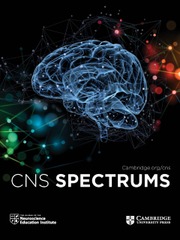Crossref Citations
This article has been cited by the following publications. This list is generated based on data provided by
Crossref.
Hwang, S.
Nolan, Z. T.
White, S. F.
Williams, W. C.
Sinclair, S.
and
Blair, R. J. R.
2016.
Dual neurocircuitry dysfunctions in disruptive behavior disorders: emotional responding and response inhibition.
Psychological Medicine,
Vol. 46,
Issue. 7,
p.
1485.
Sonuga‐Barke, Edmund J. S.
Cortese, Samuele
Fairchild, Graeme
and
Stringaris, Argyris
2016.
Annual Research Review: Transdiagnostic neuroscience of child and adolescent mental disorders – differentiating decision making in attention‐deficit/hyperactivity disorder, conduct disorder, depression, and anxiety.
Journal of Child Psychology and Psychiatry,
Vol. 57,
Issue. 3,
p.
321.
Bubenzer‐Busch, S.
Herpertz‐Dahlmann, B.
Kuzmanovic, B.
Gaber, T. J.
Helmbold, K.
Ullisch, M. G.
Baurmann, D.
Eickhoff, S. B.
Fink, G. R.
and
Zepf, F. D.
2016.
Neural correlates of reactive aggression in children with attention‐deficit/hyperactivity disorder and comorbid disruptive behaviour disorders.
Acta Psychiatrica Scandinavica,
Vol. 133,
Issue. 4,
p.
310.
Taber, Katherine H.
Lindstrom, Cassie M.
and
Hurley, Robin A.
2016.
Neural Substrates of Antisocial Personality Disorder: Current State and Future Directions.
The Journal of Neuropsychiatry and Clinical Neurosciences,
Vol. 28,
Issue. 4,
p.
A4.
Stadler, Christina
Manetsch, Madleina
and
Vriends, Noortje
2016.
Dialektisch-behaviorale Behandlungsansätze bei aggressiven Verhaltensstörungen.
Zeitschrift für Kinder- und Jugendpsychiatrie und Psychotherapie,
Vol. 44,
Issue. 6,
p.
443.
Besteher, Bianca
Squarcina, Letizia
Spalthoff, Robert
Bellani, Marcella
Gaser, Christian
Brambilla, Paolo
and
Nenadić, Igor
2017.
Brain structural correlates of irritability: Findings in a large healthy cohort.
Human Brain Mapping,
Vol. 38,
Issue. 12,
p.
6230.
Menks, Willeke Martine
Furger, Reto
Lenz, Claudia
Fehlbaum, Lynn Valérie
Stadler, Christina
and
Raschle, Nora Maria
2017.
Microstructural White Matter Alterations in the Corpus Callosum of Girls With Conduct Disorder.
Journal of the American Academy of Child & Adolescent Psychiatry,
Vol. 56,
Issue. 3,
p.
258.
Villemonteix, Thomas
Marx, Ivo
Septier, Mathilde
Berger, Christoph
Hacker, Thomas
Bahadori, Sara
Acquaviva, Eric
and
Massat, Isabelle
2017.
Attentional control of emotional interference in children with ADHD and typically developing children: An emotional N-back study.
Psychiatry Research,
Vol. 254,
Issue. ,
p.
1.
Susa Erdogan, Georgiana
Benga, Oana
and
Marină, Crina
2017.
Attentional Orientation Patterns toward Emotional Faces and Temperamental Correlates of Preschool Oppositional Defiant Problems: The Moderating Role of Callous-Unemotional Traits and Anxiety Symptoms.
Frontiers in Psychology,
Vol. 8,
Issue. ,
Clanton, Roberta L.
Baker, Rosalind H.
Rogers, Jack C.
and
De Brito, Stéphane A.
2017.
Handbook of DSM-5 Disorders in Children and Adolescents.
p.
499.
Fehlbaum, Lynn V.
Raschle, Nora M.
Menks, Willeke M.
Prätzlich, Martin
Flemming, Eva
Wyss, Letizia
Euler, Felix
Sheridan, Margaret
Sterzer, Philipp
and
Stadler, Christina
2018.
Altered Neuronal Responses During an Affective Stroop Task in Adolescents With Conduct Disorder.
Frontiers in Psychology,
Vol. 9,
Issue. ,
White, Stuart F.
Thornton, Laura C.
Leshin, Joseph
Clanton, Roberta
Sinclair, Stephen
Coker-Appiah, Dionne
Meffert, Harma
Hwang, Soonjo
and
Blair, James R.
2018.
Looming Threats and Animacy: Reduced Responsiveness in Youth with Disrupted Behavior Disorders.
Journal of Abnormal Child Psychology,
Vol. 46,
Issue. 4,
p.
741.
Calzada-Reyes, Ana
Alvarez-Amador, Alfredo
Galán-García, Lidice
and
Valdés-Sosa, Mitchell
2019.
Sex differences in QEEG in adolescents with conduct disorder and psychopathic traits.
Annals of Clinical Neurophysiology,
Vol. 21,
Issue. 1,
p.
16.
Bolhuis, Koen
Viding, Essi
Muetzel, Ryan L.
El Marroun, Hanan
Kocevska, Desana
White, Tonya
Tiemeier, Henning
and
Cecil, Charlotte A.M.
2019.
Neural Profile of Callous Traits in Children: A Population-Based Neuroimaging Study.
Biological Psychiatry,
Vol. 85,
Issue. 5,
p.
399.
van Gerven, Joop
2019.
Translational Medicine in CNS Drug Development.
Vol. 29,
Issue. ,
p.
39.
Stadler, C.
2019.
Lehrbuch der Verhaltenstherapie, Band 3.
p.
475.
Rowlands, Abby
Fisher, Melissa
Mishra, Jyoti
Nahum, Mor
Brandrett, Benjamin
Reinke, Michael
Caldwell, Michael
Kiehl, Kent A.
and
Vinogradov, Sophia
2020.
Cognitive Training for Very High Risk Incarcerated Adolescent Males.
Frontiers in Psychiatry,
Vol. 11,
Issue. ,
Weissman, David G.
Jenness, Jessica L.
Colich, Natalie L.
Miller, Adam Bryant
Sambrook, Kelly A.
Sheridan, Margaret A.
and
McLaughlin, Katie A.
2020.
Altered Neural Processing of Threat-Related Information in Children and Adolescents Exposed to Violence: A Transdiagnostic Mechanism Contributing to the Emergence of Psychopathology.
Journal of the American Academy of Child & Adolescent Psychiatry,
Vol. 59,
Issue. 11,
p.
1274.
von Polier, Georg G.
Herpertz‐Dahlmann, Beate
Konrad, Kerstin
and
Vloet, Timo D.
2020.
The Wiley International Handbook on Psychopathic Disorders and the Law.
p.
507.
Aghajani, Moji
Klapwijk, Eduard T.
Andershed, Henrik
Fanti, Kostas A.
van der Wee, Nic J.A.
Vermeiren, Robert R.J.M.
and
Colins, Olivier F.
2021.
Neural processing of socioemotional content in conduct-disordered juvenile offenders with limited prosocial emotions.
Progress in Neuro-Psychopharmacology and Biological Psychiatry,
Vol. 105,
Issue. ,
p.
110045.

